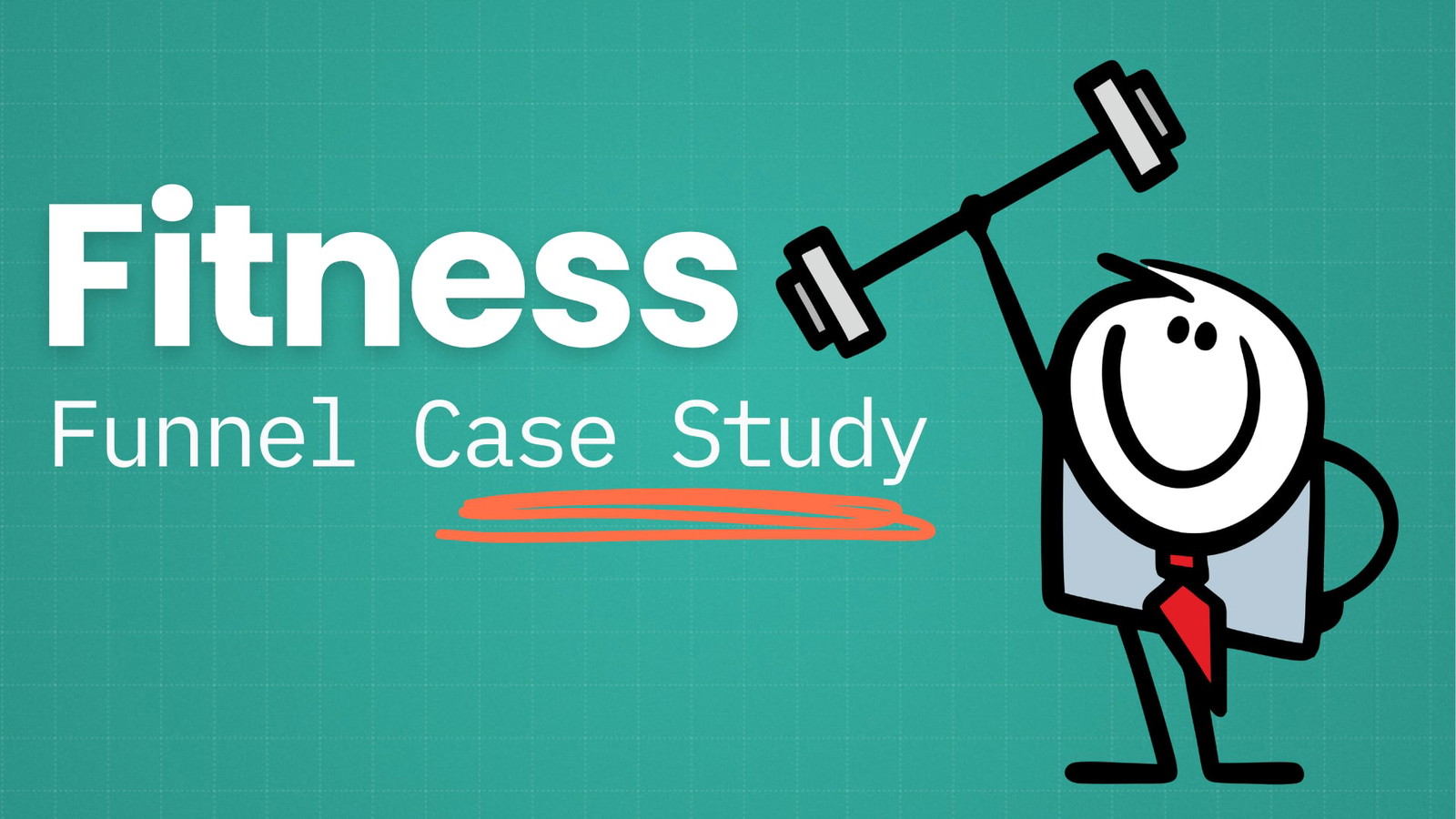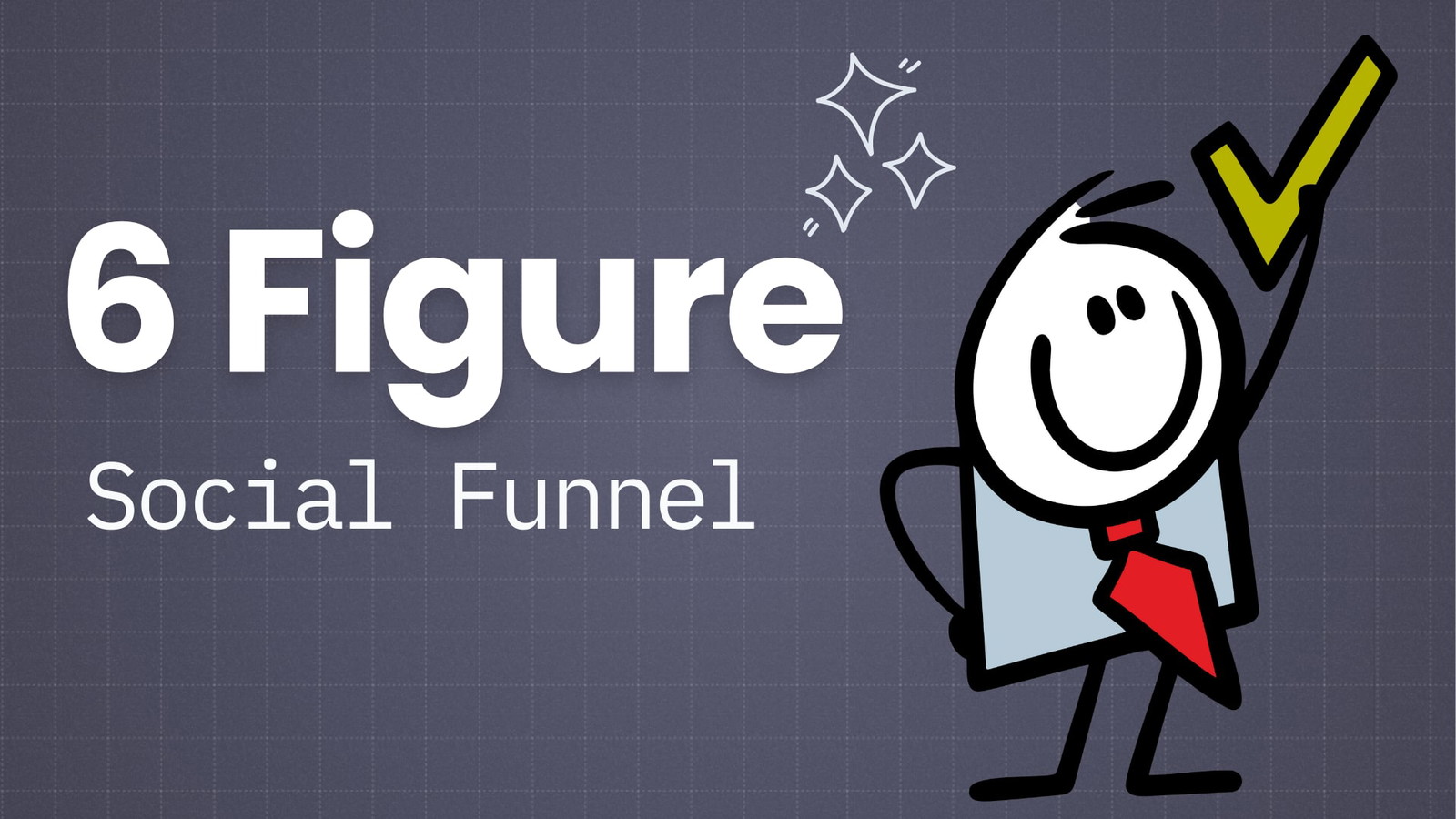AI writing assistants like Jasper can really help you pump out a lot of content in a really short span of time.
SEO content tools like Surfer SEO will help you figure out what headlines and keywords to use in an article.
So what if you mixed them together?
That’s the answer Frase IO tried to answer.
If you want that answer, keep reading our Frase IO review.
What Is Frase IO
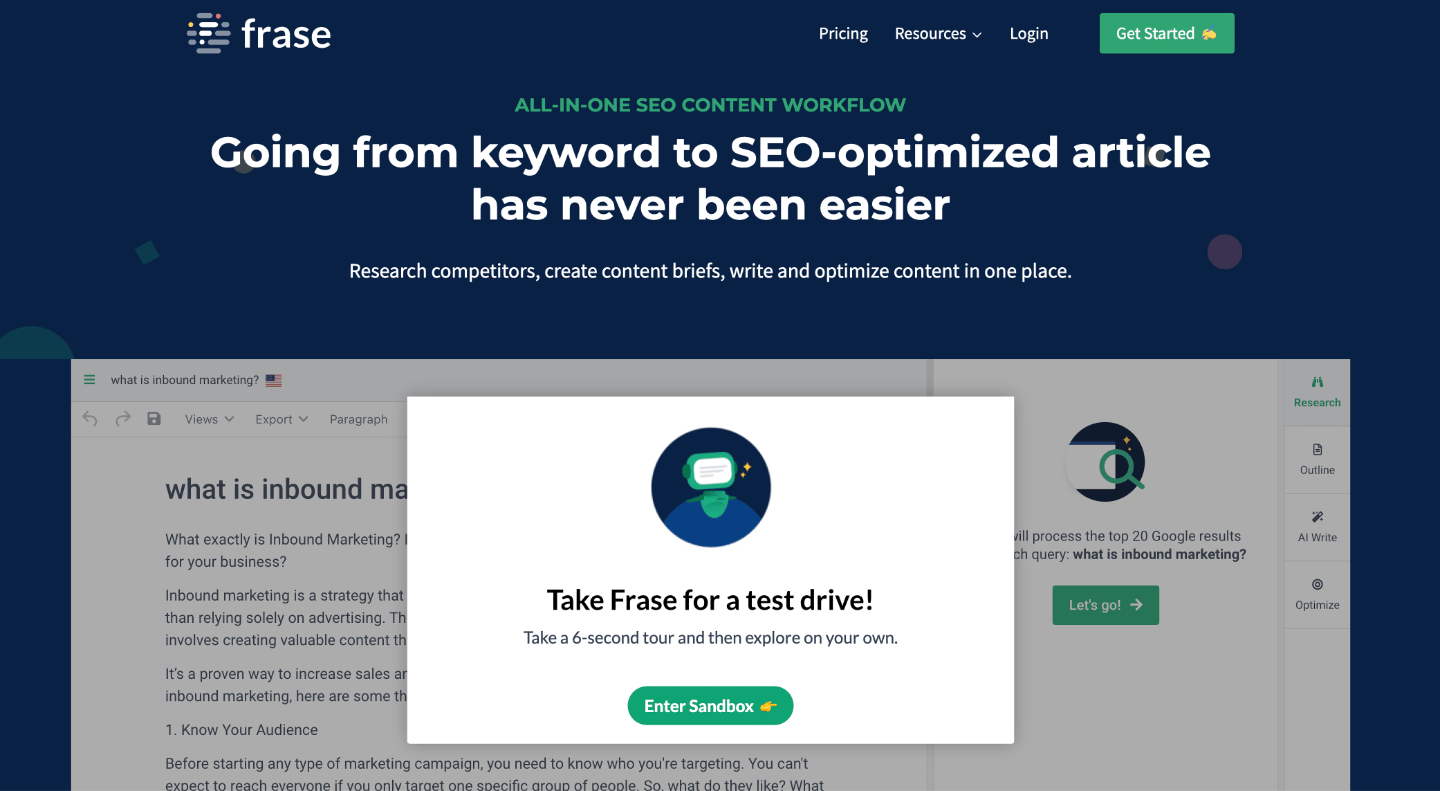
Frase IO is a content writing assistant.
It can help you save precious editorial time in a few ways:
- By researching topics
- By generating content outlines
- By using AI to write content
Frase can, as such, save you the time you’d spend researching search intent, preparing an article draft, and even writing sections of your article.
But how good is it?
Can it actually save you time?
I think so, yes.
At least as far as generating content outlines is concerned. That feature is extremely helpful and accurate with its suggestions.
However, things get a bit more complicated with AI content generation and all the other bells and whistles Frase IO has.
So if you want to know whether or not Frase IO will be worth it for you, keep reading our review.
How Does Frase IO Work? A Quick Tour
You can’t try Frase IO for free, so unfortunately, you’ll need to purchase one of their subscription plans to get started with the tool.
If you do, you will be met with a short guide helping you get started with Frase IO:

This is the main dashboard of the software:
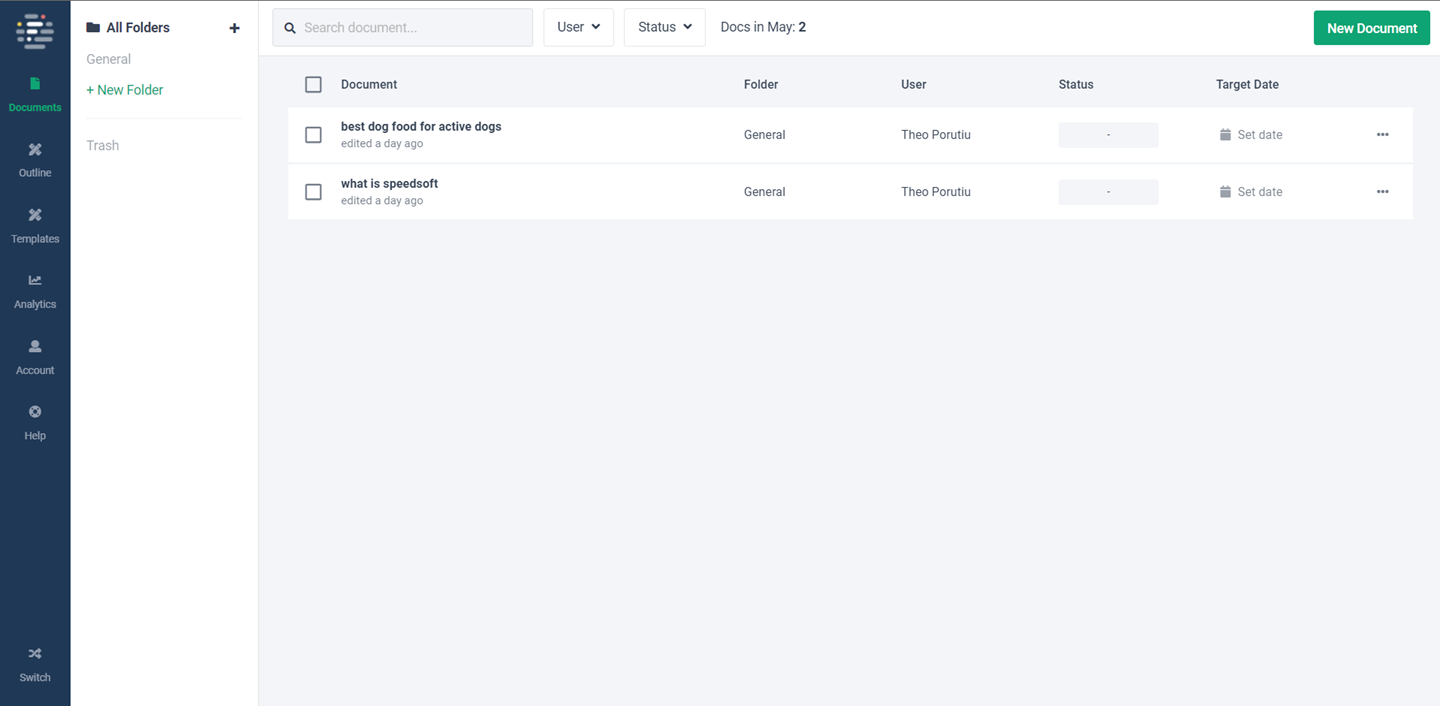
On the left, you can open documents:
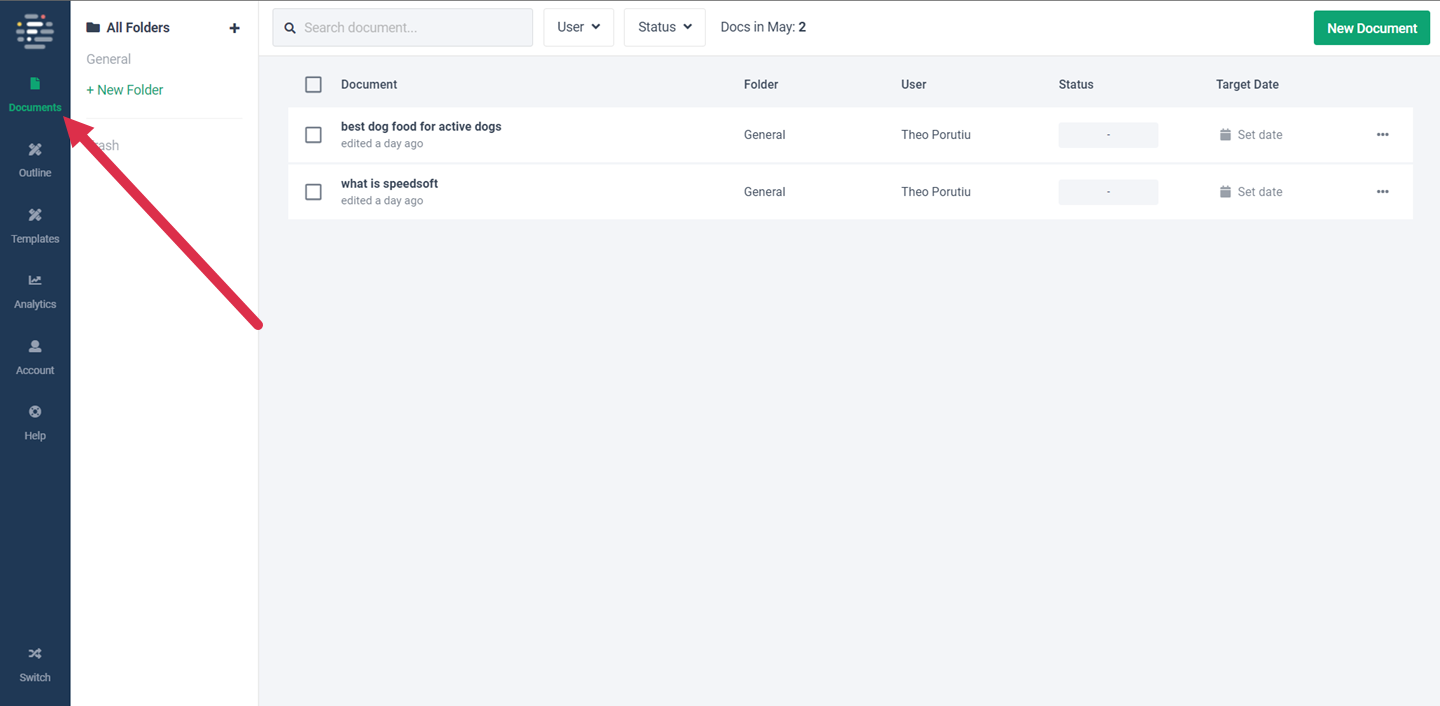
Which is by far the crowning jewel of Frase, as it helps you figure out what other articles are doing for your target search query.

As well as an idea of what people want to read about:
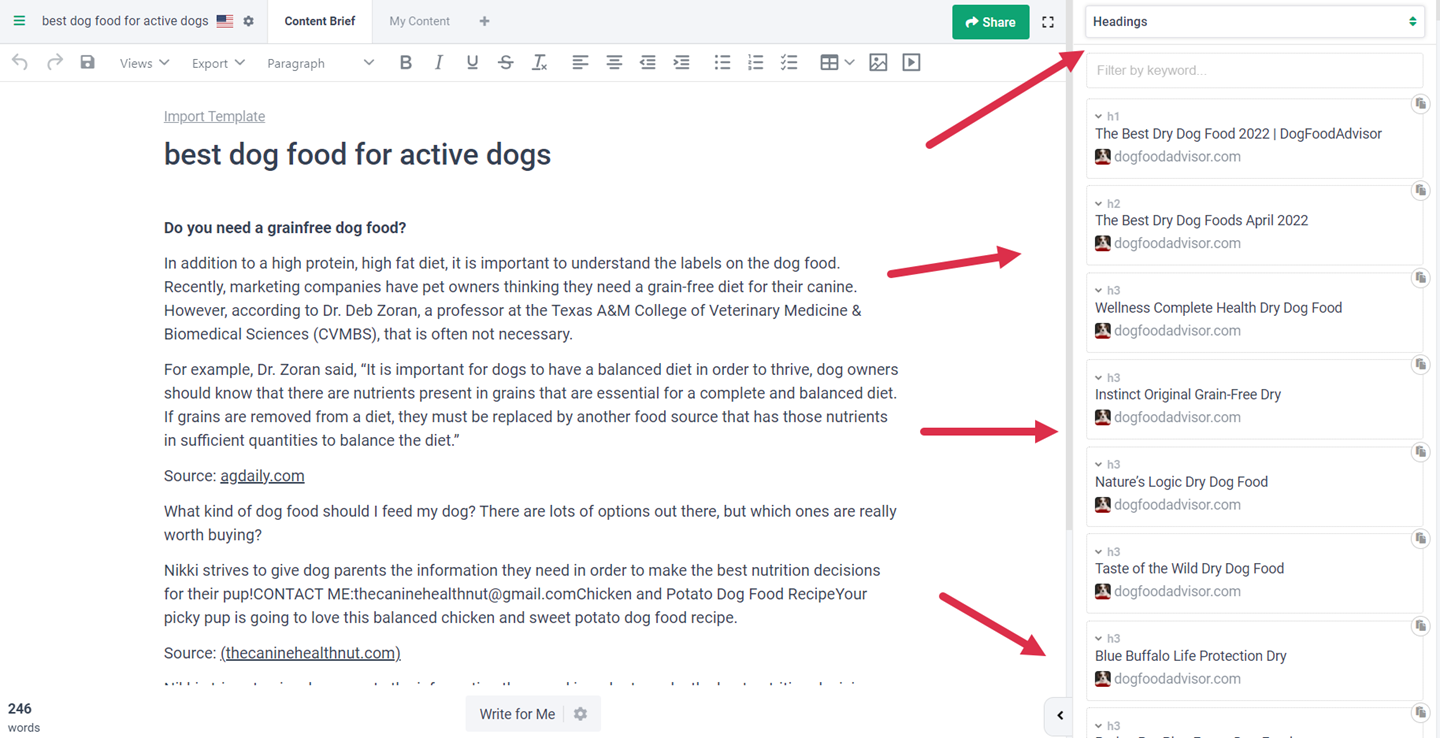
And what questions people have about the topic:
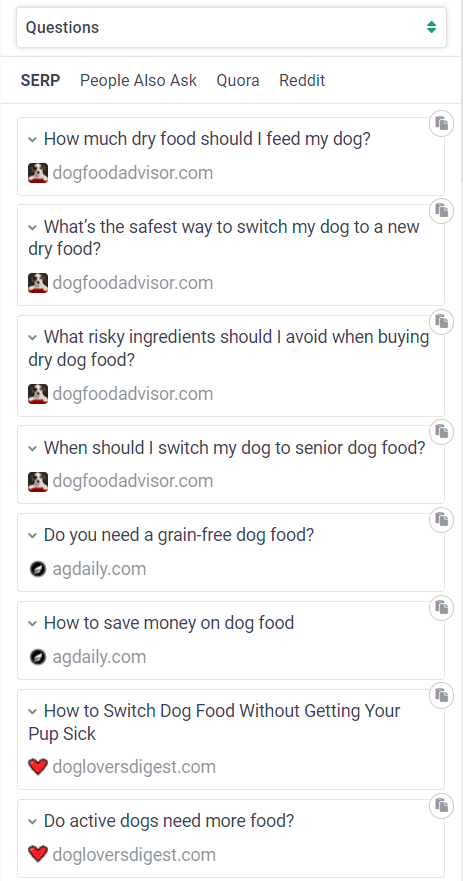
This is the core of Frase io, and it’s a great feature if you want to find article ideas quicker, and sort out an article’s structure faster.
Beyond research and optimization, you can also use Frase to generate AI content:

But how good is this output?
It’s not too good. Here’s an example of how Frase io generated content for one of our dog food articles:
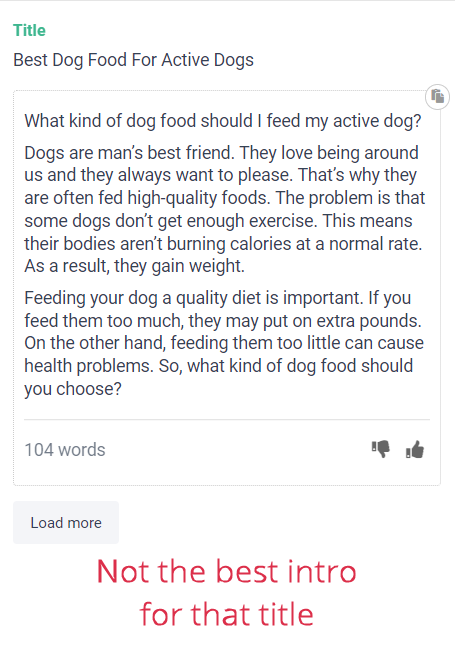
AI writing in general is pretty bad with dog food articles because it’s a small niche, so tools can’t research it properly.
But even compared to other tools like Jasper or Rytr, Frase io performed a bit worse.
And all of this is for a pretty high price point. The cheapest you can get Frase io for is $44/month, more than both Copy AI and Rytr. But to get all SEO features, you’ll pay $80/month.
So Frase io may be a bit lacking when it comes to content generation.
But that doesn’t mean it’s useless. So let’s analyze its features more in-depth, to see what it gets right, and what could be improved.
Frase IO Features: Everything You Can Use
Frase IO may seem like it’s light in features.
But there is a lot more in its toolset than you’d expect. Each core feature, like the research tab, has its own subset of features.
These are usually quality of life tools, but they’re extremely helpful nonetheless:

So keep this in mind while we analyze Frase’s toolset.
Documents, Research, And Questions
Frase’s main tool, which helps sell the software, is its research tool.
To access it, you’ll need to create a new document. Fill in your keyword, then, click on the Research tab on the left:
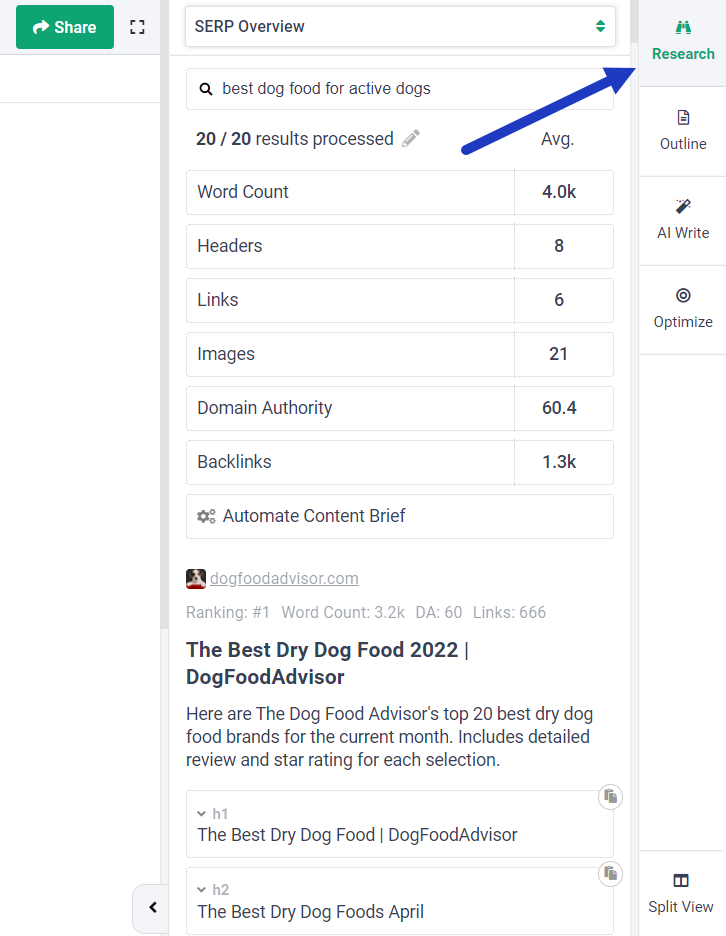
This will analyze the first 20 SERP results and generate a very helpful content brief, which includes:
- An overview of the SERP for the chosen keyword
- A list of potential headings you can use in an article
- A list of potential resources you can link to in your piece
- Statistics that your competition refers to
- News articles you can link to
- Wikipedia topics on the subject you’re writing about
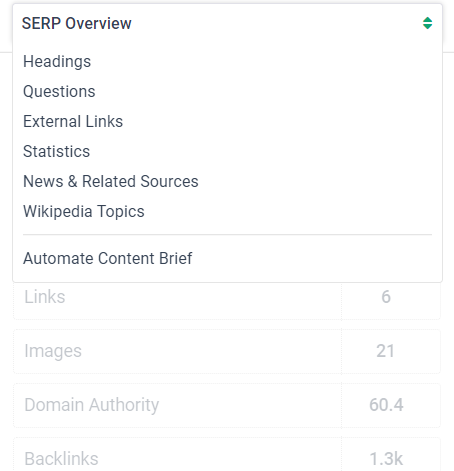
It’s an interesting set-up to reverse engineer successful articles, pinpoint what worked for them, and pick and choose what to use in your own piece.
Also, it’s a fast way to find valuable resources on the topic you want to write about.
However, this content brief is a double-edged sword.
Frase’s research is limited to what your competition already does on the SERP.
It’s helpful. You’ll get an estimate for the monthly search volume, and all the keywords you need to target, and you’ll understand what search engines want from results in a particular keyword.
But it won’t be enough if you want to stand out among your competitors, and write an original article.
Except for the questions section.
There, Fraser will come up with things people usually ask, based on your competition’s articles. But it can also research Quora, People Also Ask, and Reddit to come up with those.

And keep in mind: these questions aren’t just valuable for drafting an FAQ section for your article.
These are the questions your future readers have about a topic. Questions you’ll need to answer with your article, social media post, or YouTube video.

So the research is a strong point of Frase.
But the questions are the ones that truly shine.
Whipping Up A Content Outline In Frase IO
With the research you generated before, you can also create an outline for your article.
To do it, you’ll need to browse the headings your competitors use:
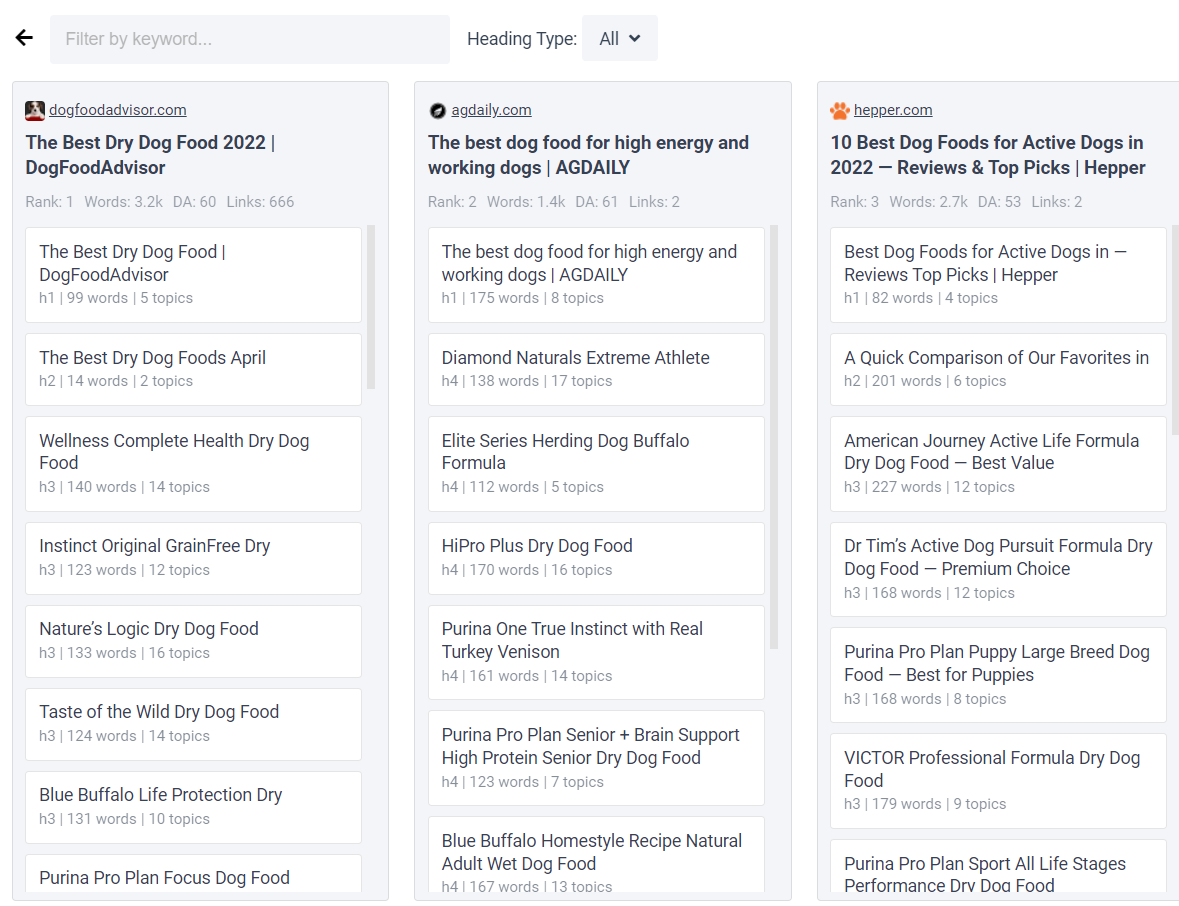
And paste the ones you like into your outline:
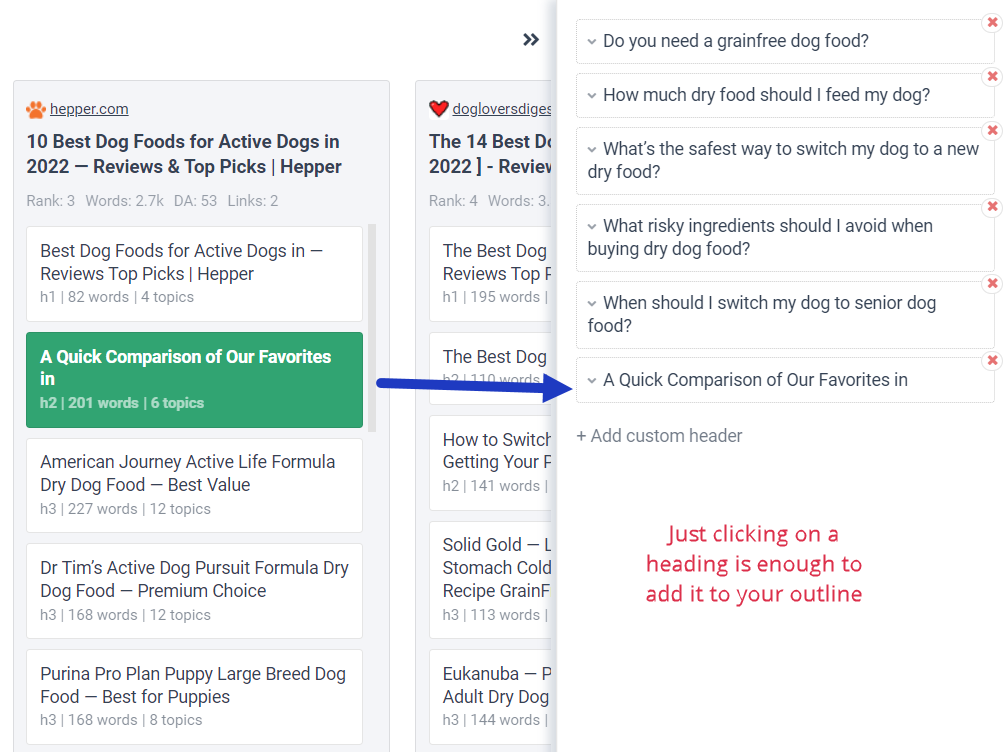
This system is really easy to use and more complex than you’d expect. You can browse through different types of headings:

And even search for a target keyword that you want to feature in a heading:
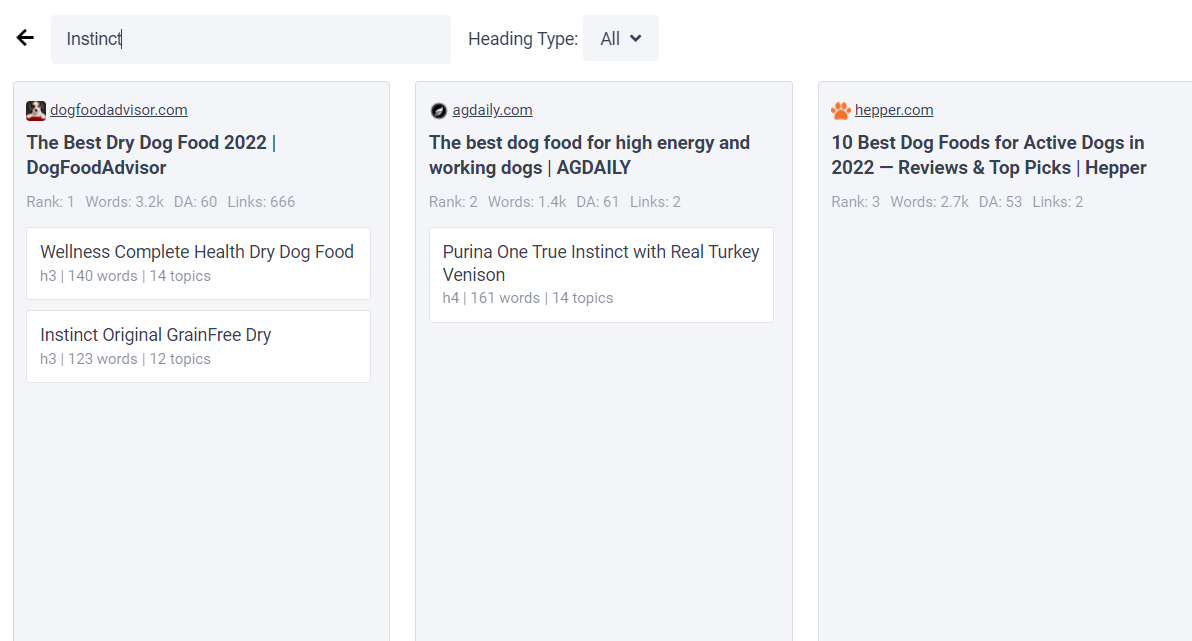
Oh and, of course, you can add your own:
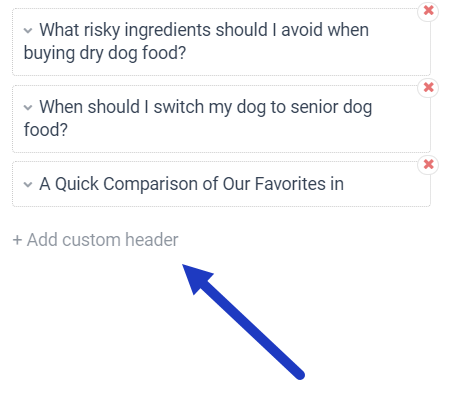
This process will help you generate a content outline that you can use to structure your article.
And this is a much better feature than what you get in AI writing tools like Jasper, Copy AI, or Rytr.
But it gets better. If you don’t want to bother analyzing all of these, you can just let Frase generate a content brief for you:

The results are not bad!
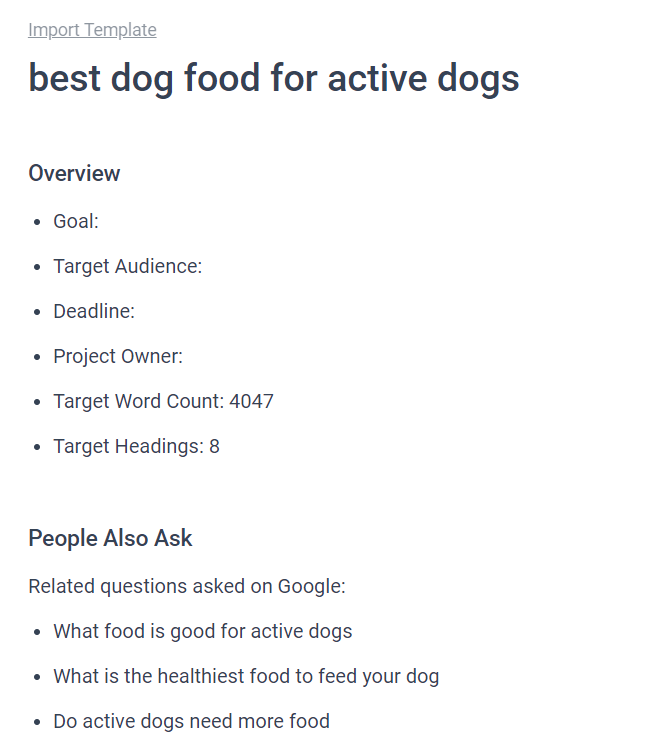
You will have to edit them a little bit.
But the outline is good enough to get you started. And a huge time saver.
Content Generation In Frase IO: Is It Any Good
Frase’s SEO and content planning tools seem to be quite helpful.
So what about its content generation?
Can you create content faster with Frase?
Their AI writer has dozens of templates that you can choose from:
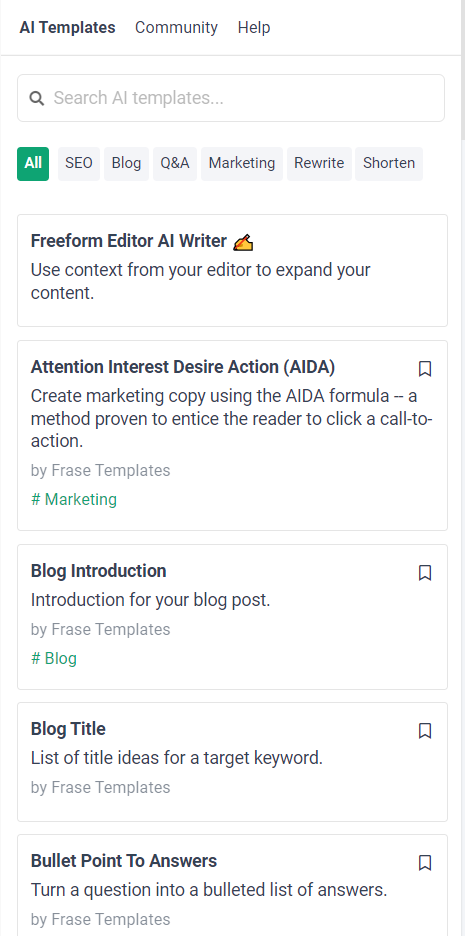
The output of AI content generation will, of course, differ based on the template you choose.
We’ll talk more about each template in a minute. For now, let’s stick to the workflow and see how you can use the outline you generated to write an article.
There are 5 big templates that you can use for blogs:
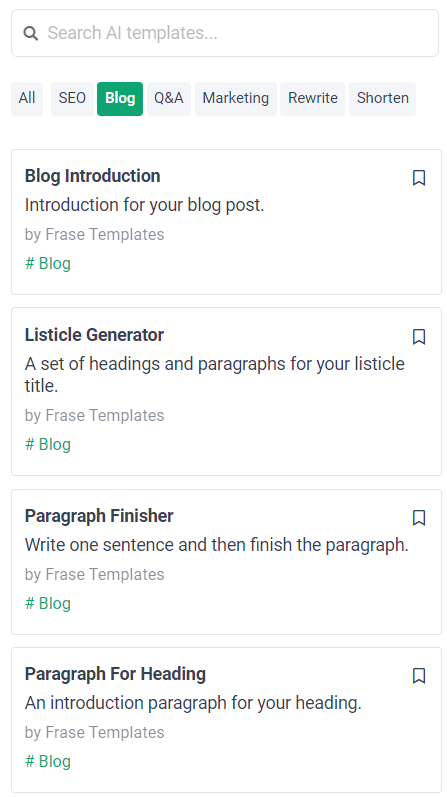
Let’s take the introduction template as an example:

After you fill in your title, you can add more input fields:
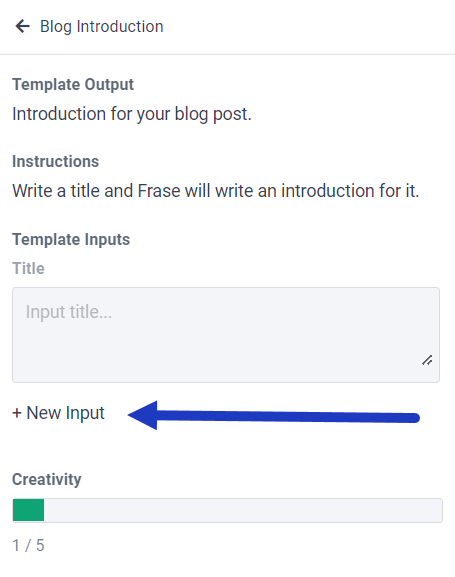
And you can choose a creativity level:

But I didn’t see a huge difference between content generated with a creativity level of 1, or 5.
Of course, with just a title, the content generated is not amazing:

It does the job somewhat. And it’s really convenient that you can add the sections you generate by just clicking on them:
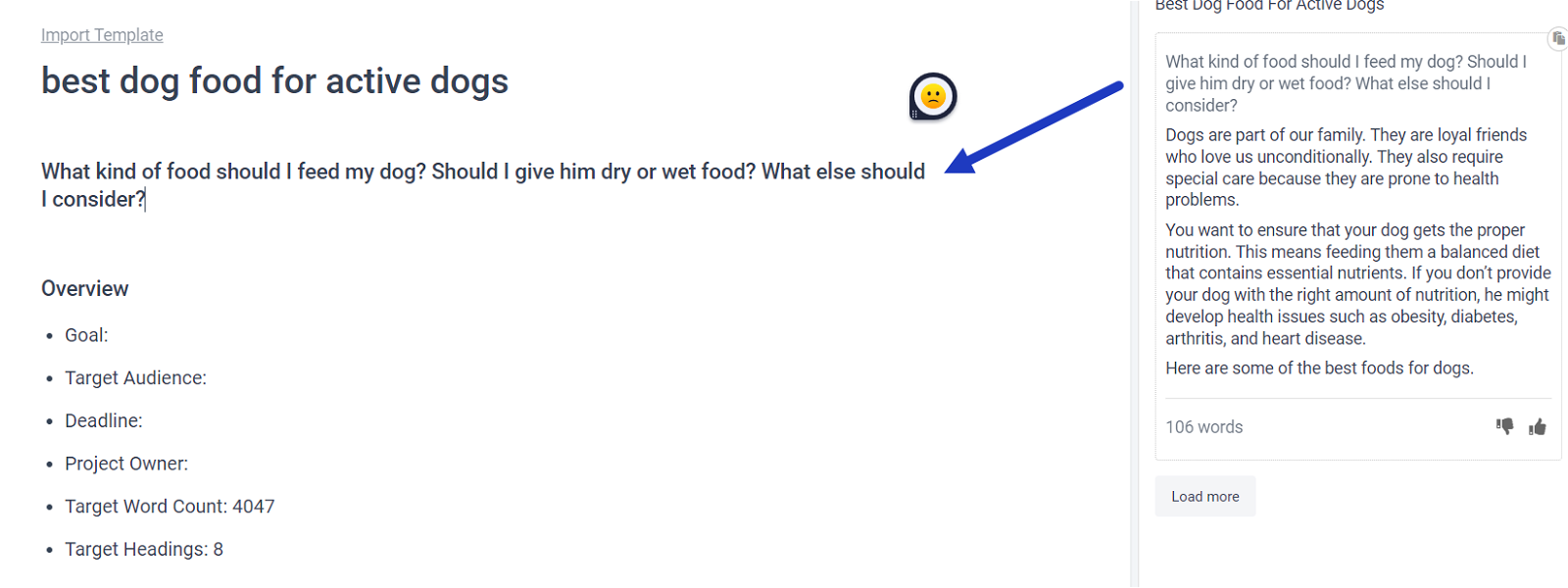
Intros are one thing though. Writing a full article is very different. Can you do it in Frase?
Technically, yes.
You can paste a paragraph, and then tell Frase to finish writing it for you:
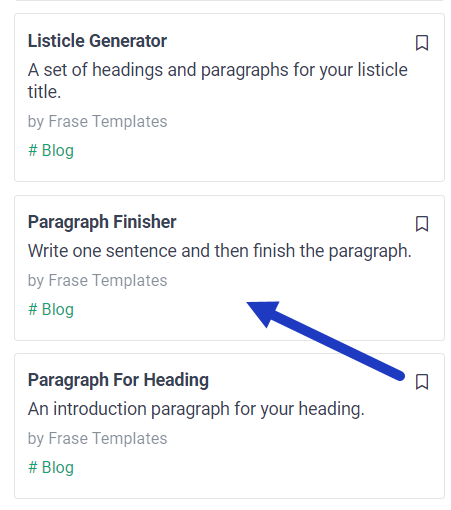
That’s the most effective way to do it.
But it’s still extremely slow. You can’t just paste a piece of content, and tell Frase to work with it, like you would in Jasper or Rytr.
You need to copy and paste individual paragraphs/parts of paragraphs, and then have Frase expand on them.
It’s slow. But these aren’t all the aces up Fraser’s sleeve. If you wan to find out more, keep reading our Frase IO review.
Content Optimization: A Saving Grace
If you’re familiar with Surfer’s content editor, you already know how this one works.
You get a list of commonly used keywords, based on what your competition is writing about:
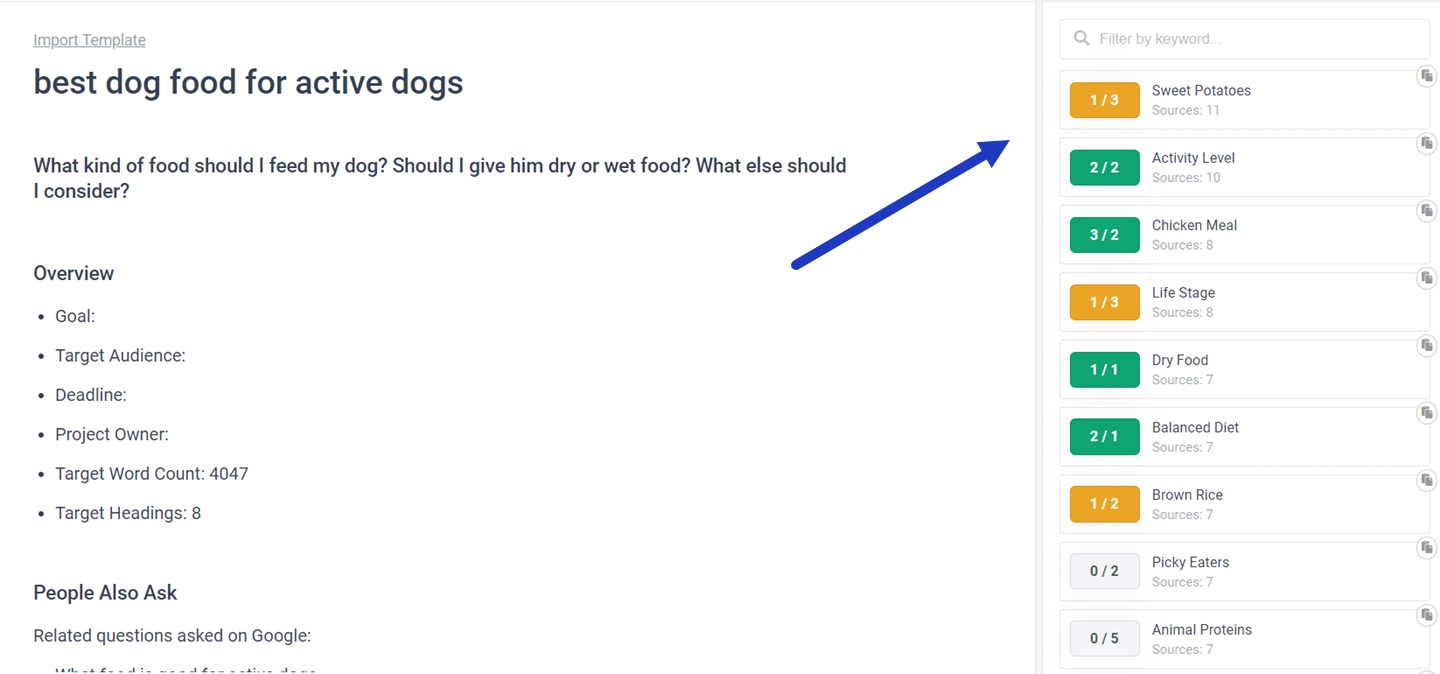
As well as some information about how often you should use them in your text, and a score for how well your article is doing content-wise:
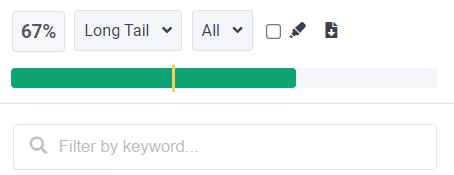
However, the keyword recommendations in Frase differ slightly from those in Surfer. And I know for a fact that Surfer SEO works, and really well. If you don’t believe me, read our Surfer SEO review.
So I don’t know what to say about these recommendations.
What I do know is that seeing these recommendations in action can get pretty annoying. That’s because you don’t get a quick highlight of how they’re used like you do in Surfer:
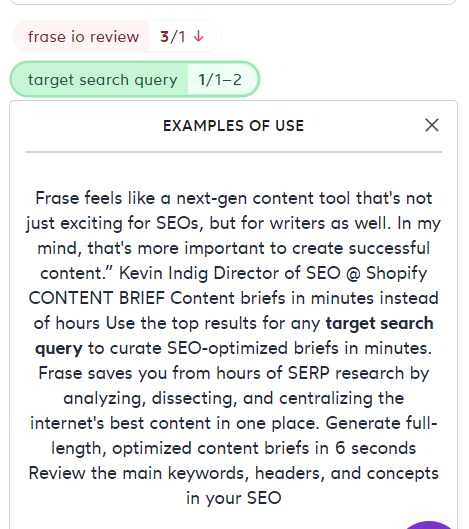
Instead, clicking on a recommendation will open a new screen, with much more information:

And this really breaks up your flow if you’re writing and you want a quick tip on how to use a keyword.
In my case, Frase bugged when I clicked on a recommendation, and it actually got stuck on it.
The back button stopped working. But even without that, the way Surfer does it is better IMO.
Integrations: How To Add Frase IO To Your Tool Stack
Frase IO boasts some integrations that can make your life easier.
Most notably, I like their Google Docs integration, which lets you use the content optimization features straight in your document:
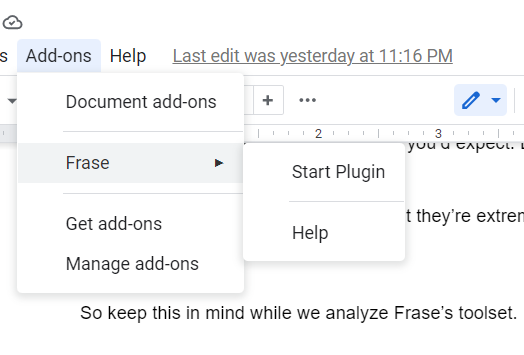
Their Google Search Console integration helps you research keywords better, based on your own performance:

And the Hubspot CRM integration is somewhat of a support automation tool.
You can use it to send messages to contacts based on Frase’s answers.
They’re also working on a WordPress integration, so you can use their content optimizer right when you upload new articles.
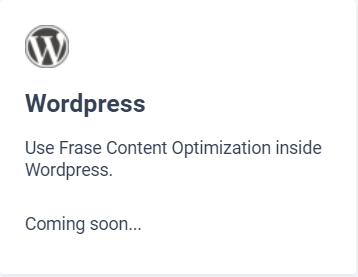
While it’s not here yet, I like their integrations.
Other Features And Perks
As I said, Frase is a complex tool, and there are a lot of helpful features hiding beneath the surface.
For starters, you can create outlines in multiple languages, not just English:
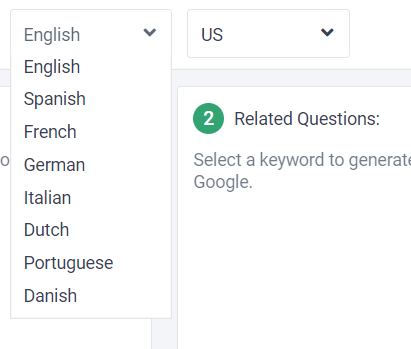
And this is really helpful, but I’ll note that the list of supported languages in Frase is much smaller than that of Jasper, Copy AI, or Rytr.
In Frase’s “Documents” tab, you can also set deadlines for your articles:
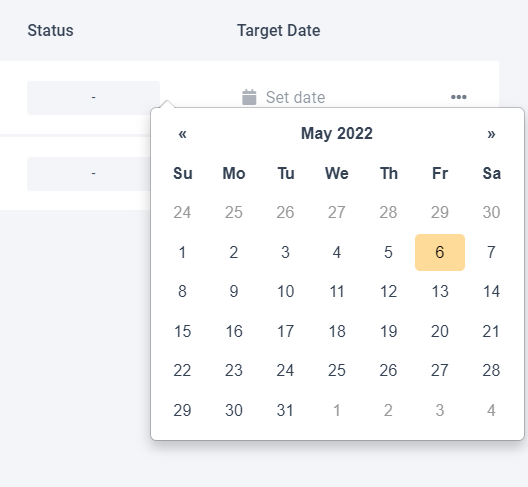
And assign a status to them:
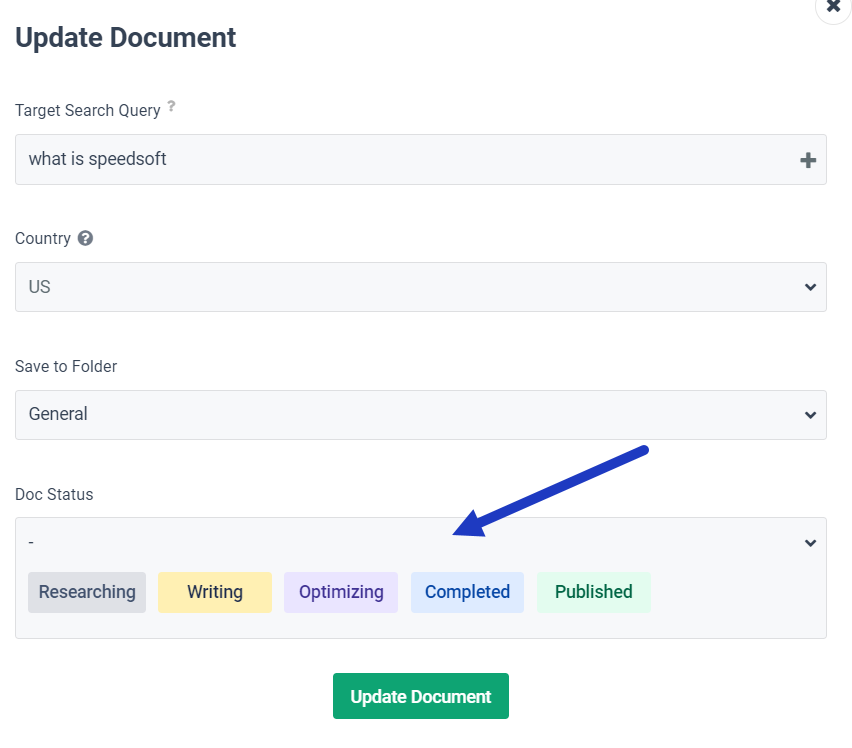
So if you want, you can use Frase as a complete article development tool, from research to publishing.
Oh and, if you integrate with the Google search console, you also get a dashboard to check your metrics.
Most of the other helpful extra tools of Frase do come with their templates, so let’s talk about that now.
Frase Templates
Frase has a ton of templates that streamline AI content generation. The most refined (and helpful) ones are built by Frase developers. But you can also build your own templates:
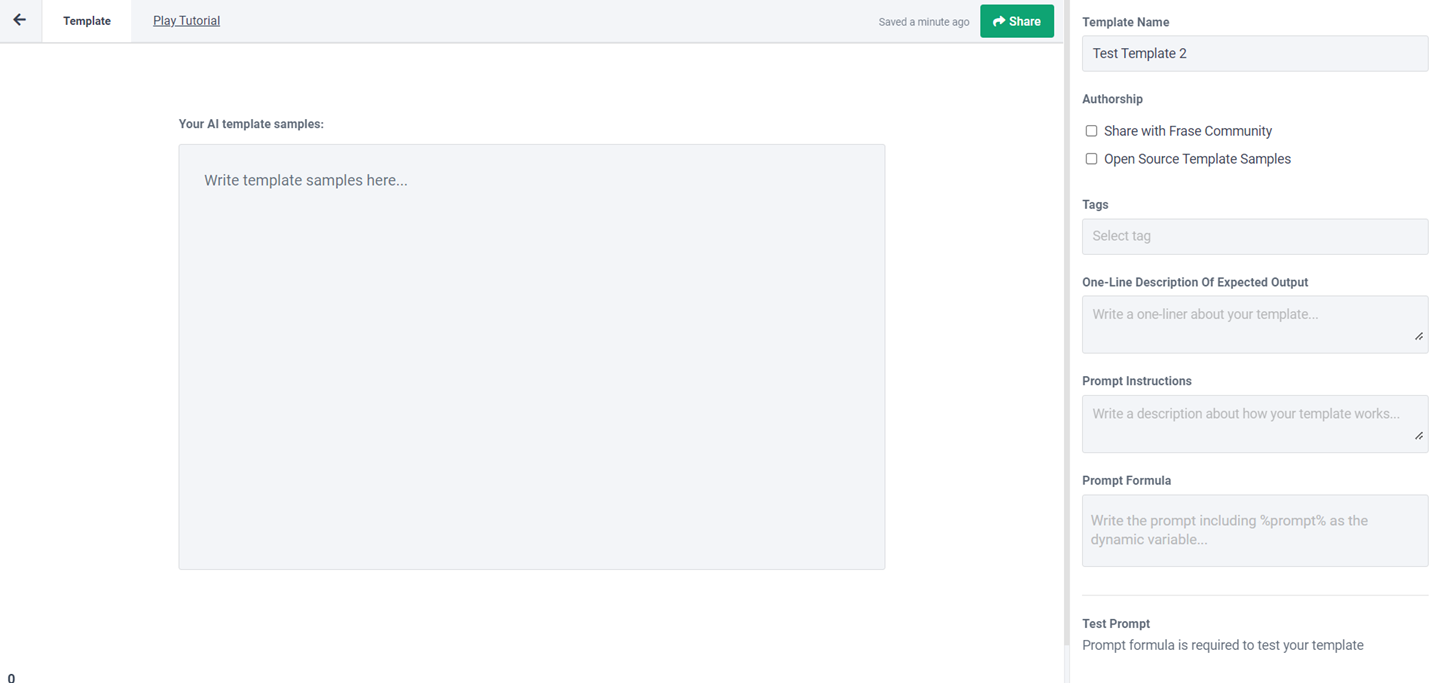
And use community-created templates:
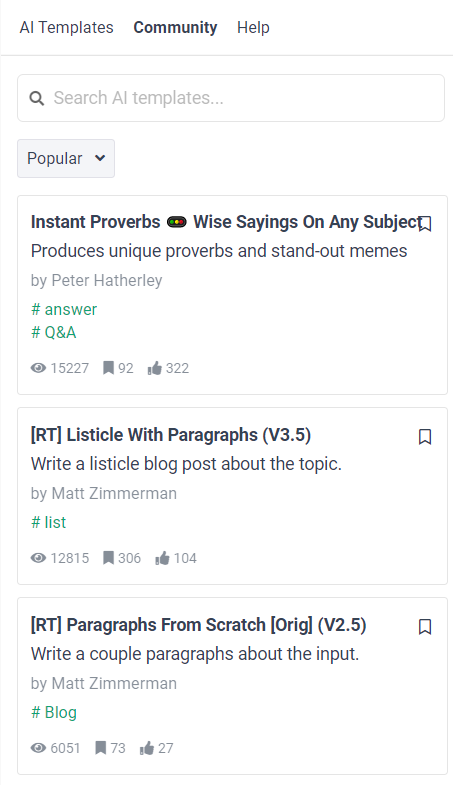
They’re a great addition. For our review though, we’ll look at the core of Frase’s templates: the built-in ones.
Questions and Answers
Frase is big on coming up with insightful questions, so it’s only natural that it has a few templates that help you answer these questions:
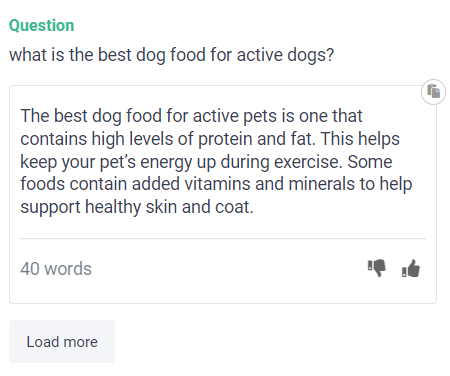
So are the answers any good?
Yes, pretty much:
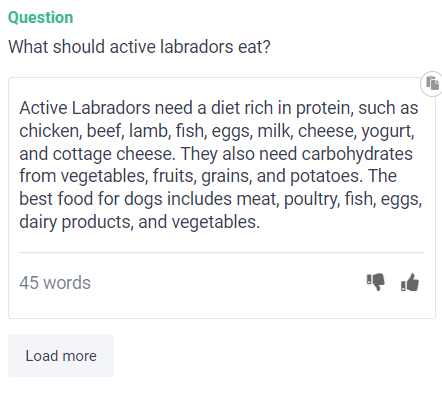
As long as you ask the software questions related to the topic research, it’ll come up with diverse and helpful answers:

Not all of them are 100% accurate, so you’ll need to fact check this output. But even with this extra hurdle, Frase IO does an amazing job at answering questions.
SEO Templates
The SEO templates help you generate meta descriptions, sections that could work for featured snippets, and more.
And I’ll be honest, the meta description template is pretty good:

And while the other templates would be better with more research, and more inputs, they’re not too bad either:

So if writing high-quality SEO content is tedious for you, these templates can help.
Except… Google doesn’t like AI-generated content. In fact, they recently came out and said they will penalize content if they determine it to be AI-generated.
I’m not sure how this can be enforced, but it’s still a risk you’re exposing yourself to if you use AI-Generated content. This applies to all blog templates as well.
Marketing Copy Made Easy By Frase
While content made for SEO shouldn’t be AI-generated, you have no restrictions for marketing copy.
And Frase has quite a lot of marketing templates:

So let’s test some of them. The AIDA format is a classic in marketing, and Frase’s output can be decent:
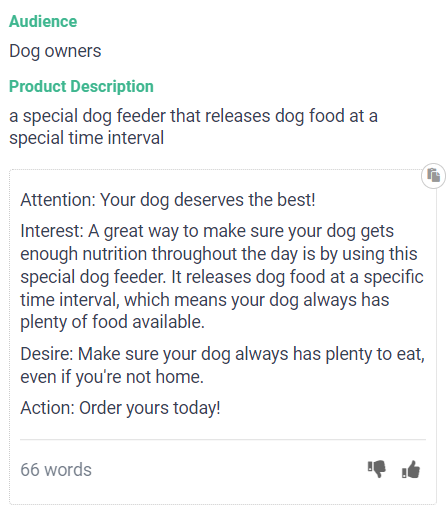
But most AI writing tools have a template for AIDA, and their output is catchier.
Some of the other templates can be valuable though.
For example, the product description is pretty decent:
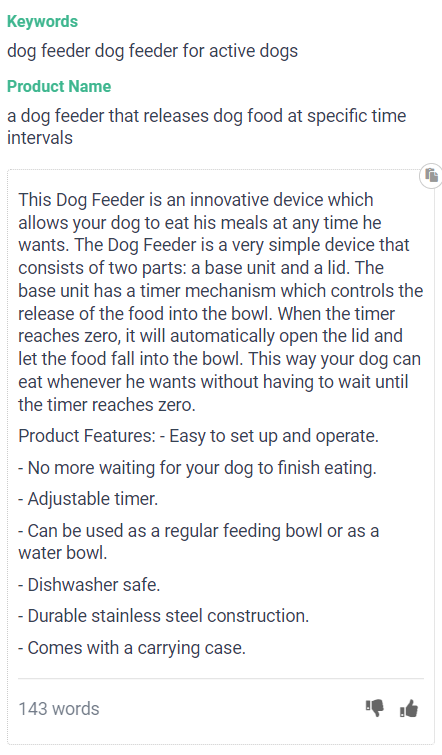
It did go a bit off the script there at the end, but it’s still a good first draft that you can quickly edit. And that’s with bad input.
So if you want to streamline writing marketing copy, Frase might be able to help. But honestly, Jasper does it a bit better.
Rewrite and Shorten
Frase IO has two more tools you can use to optimize AI-generated content.
The rewrite template will rephrase a paragraph, or sentence you give to Frase:
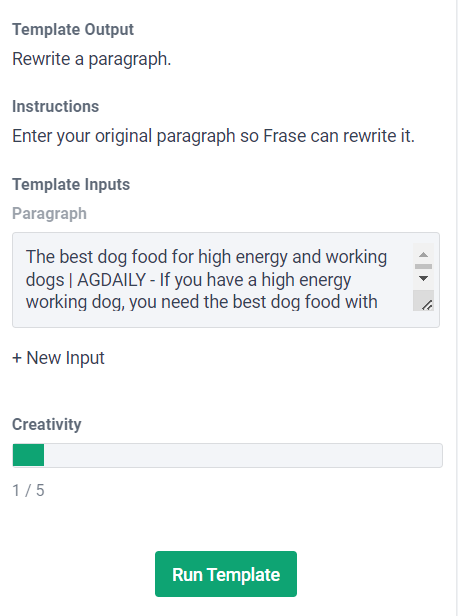
And the “shorten” template will take a paragraph and either break down in a simpler way or explain it with bullet points:
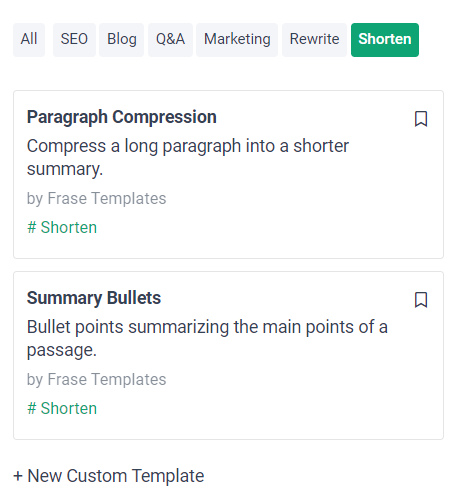
This “shorten” feature is extremely useful in most AI writing apps.
But in Frase, shortening isn’t as effective as in other AI writing tools:
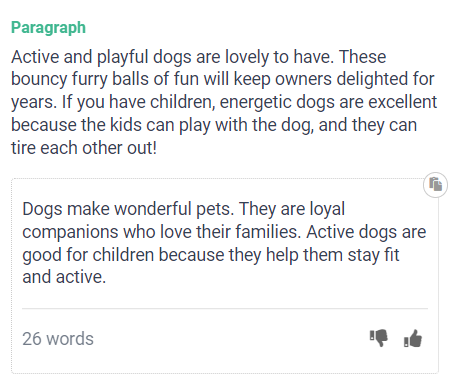
I would expect it to be… shorter.
This is a pretty big missed opportunity. Generating AI content usually involves a lot of rephrasing or breaking stuff down, both of which are easier with a functional shorten feature.
Pros When Using Frase
You’ve seen what Frase is capable of, so let’s make a short summary of what we analyzed so far in our Frase review.
First, Frase is extremely helpful for researching your competition. More so than most other SEO tools.
And its keyword research goes deeper than just estimating the organic traffic you’ll get. It actually creates helpful content briefs.
Considering the information it can deliver, it’s good at researching articles for you.
It’s also really helpful in creating a content outline:
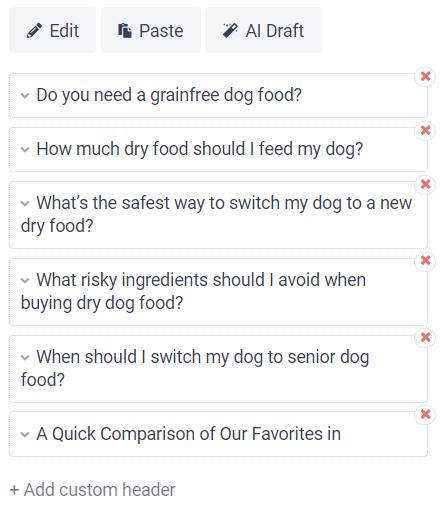
And it can save you a lot of time, especially when figuring out what questions you need to answer in your article.
AI content generation can shine sometimes, especially when creating some SEO content.
Oh and, before I don’t forget:
The integrations Frase has are pretty good:

But it’s not all rosy.
Cons When Using Frase
Frase content creation stumbles over itself more often than it shines.
Sure, the hiccups it has can be easily overcome by creating your own templates.
But compare the whole thing with other AI copywriting tools.
Simply put, other AI writing tools do a better job with the default templates. And they all support custom templates.
Another big problem with Frase is its pricing.
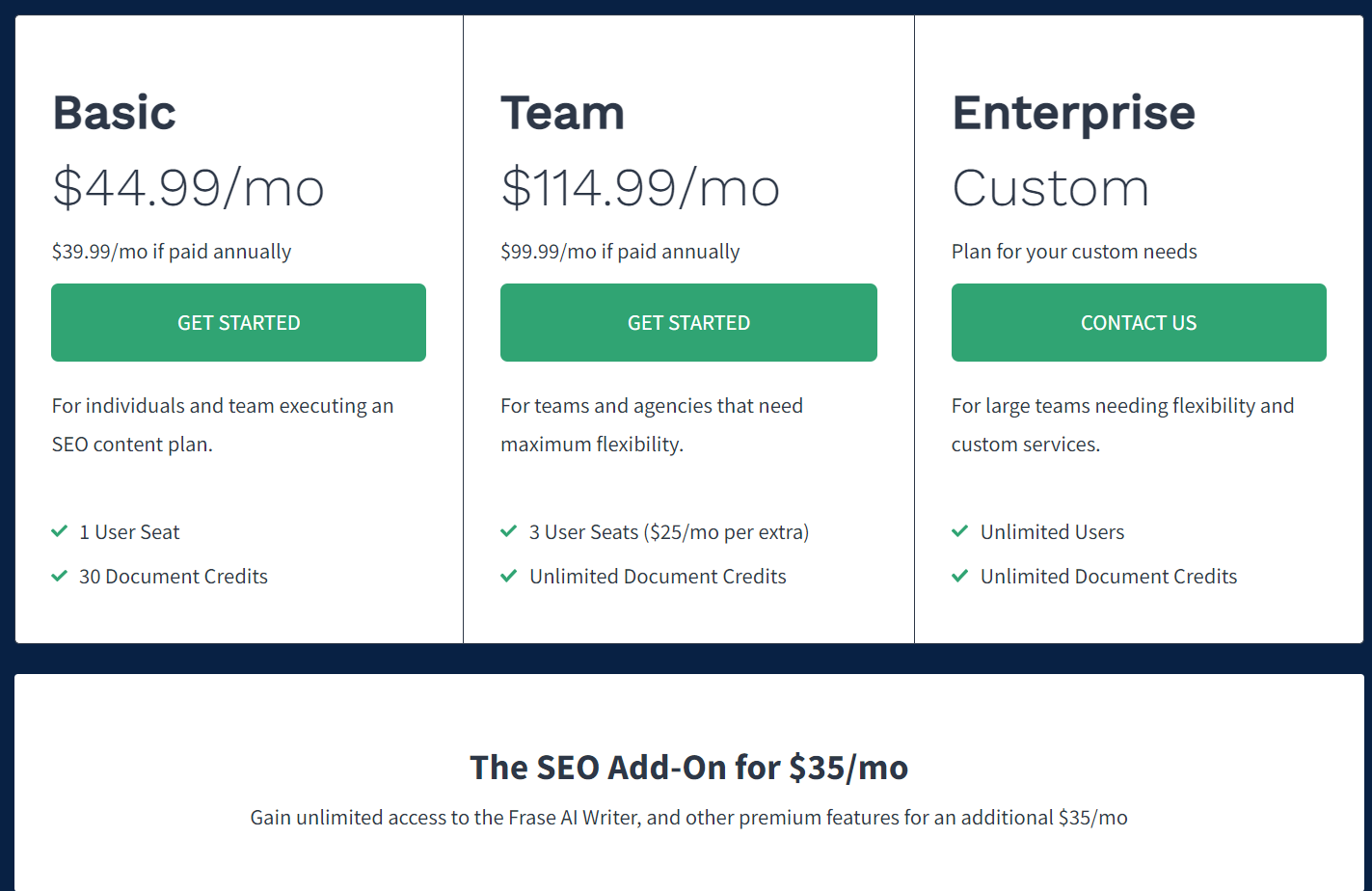
If you want the entire toolset (research and AI writing), Frase can set you back as much as $80/month. And that’s with a limit of 30 documents per month.
The expensive part is not the SEO add-on. It’s 35 bucks, as much as the competition.
Its research part is what sets you back a lot – $45/month. Again, compared to a tool like Surfer SEO, it’s pretty much on par.
But Surfer can optimize existing content better. And Jasper does AI generation better.
So if you want it all in one place, and you can sacrifice some quality, Frase is a really good choice. If you’re fine with using two tools, there is a better setup out there.
Tutorial: How I Use Frase IO
I’ve touched a bit on how I used Frase IO for this review, but I want to outline my process in depth.
I think it’s a great way to really drive home what Frase can do.
For this purpose, we’ll pretend we want to write an article from scratch on the keyword “best dog food for active dogs”.
We tested all AI writing tools in the same way, so we’ll compare the final output with everything else we got.
Let’s get into it.
First, you create a new document focused on the “best dog food for active dogs”:
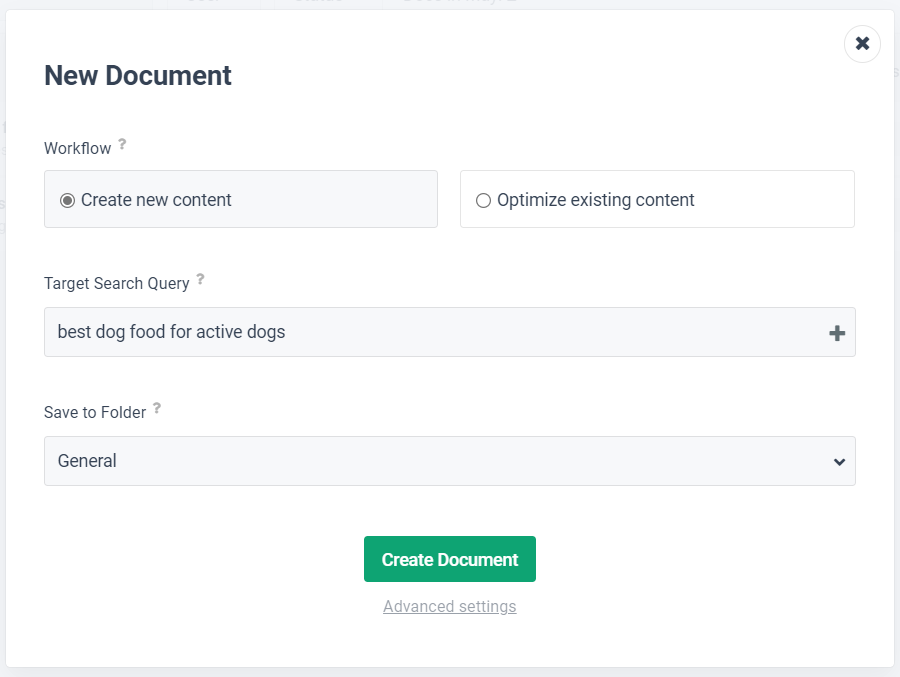
Then, you let Frase do the research:

And analyze the output.
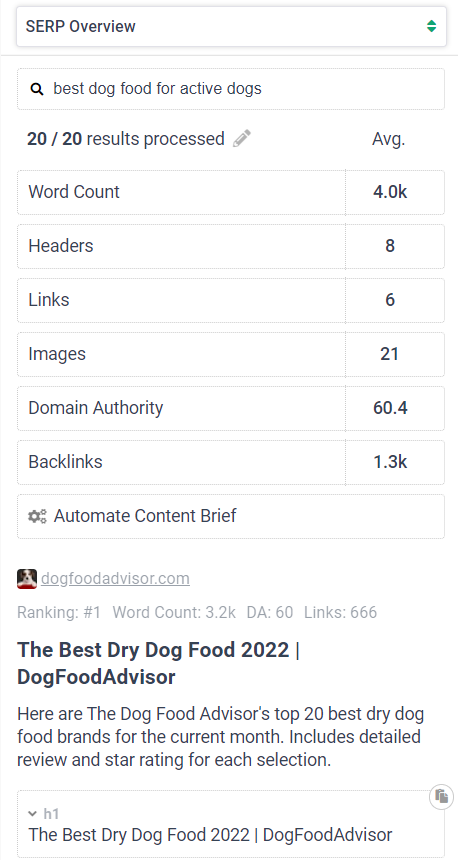
Use this output to create an outline for your article:
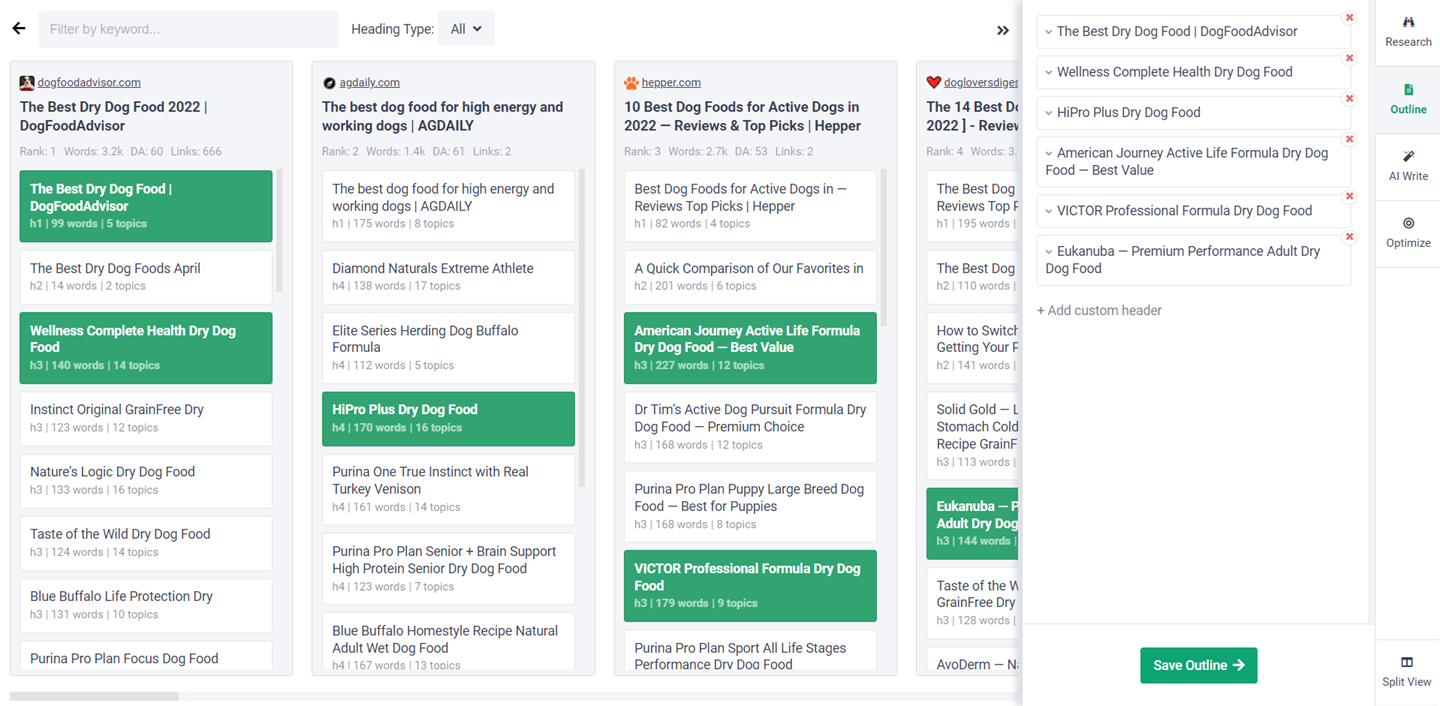
Don’t forget about the questions:
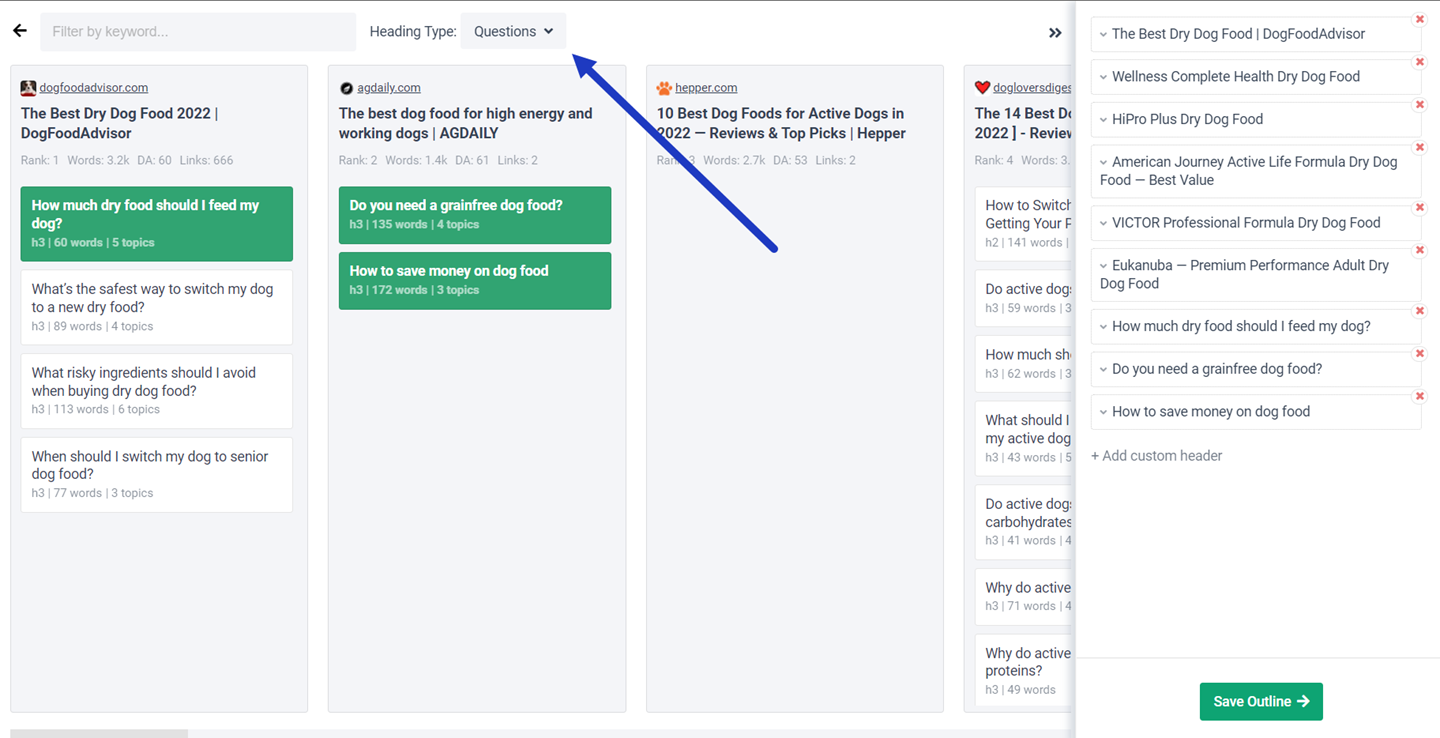
With an outline in place, you get to the hard part. Sure, you can create an introduction for your article pretty easily:
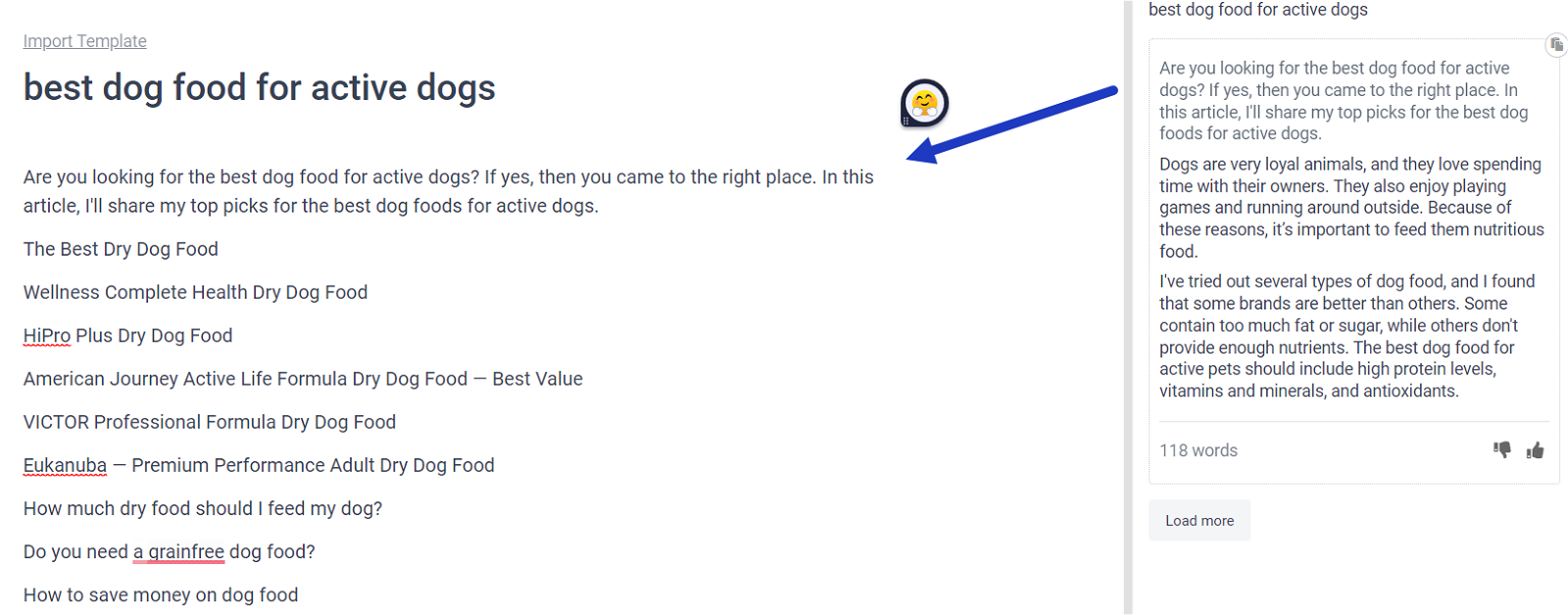
But beyond that, you’ll need to start writing each paragraph, or define it shortly, and let Frase IO take over:
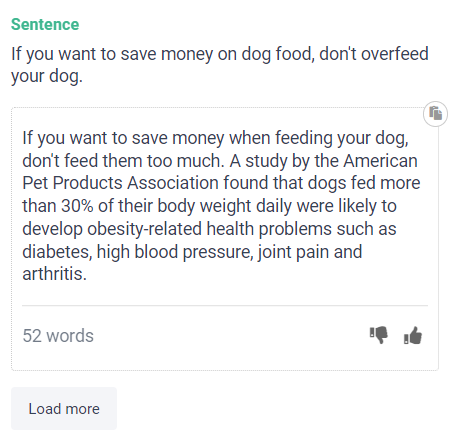
The lack of a better process for this makes Frase IO lag behind its competition. By a lot. Jasper, Copy AI, and even Rytr have better processes in place to output long-form content.
This is what the final result looks like:
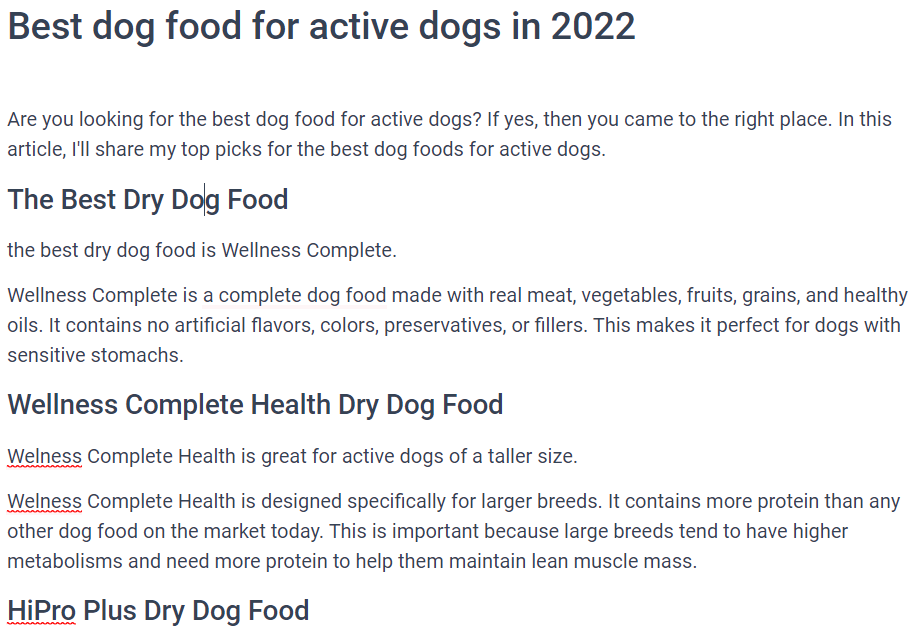
If you want to see Frase IO in action, read the whole article here.
As you can see, it’s a bit of a mess. For long-form articles, there are definitely better choices out there.
But what choices? And just how much better are they? Let’s find out.
Frase IO vs Competitors: How Viable Is Frase
It’s hard to pit Frase IO against competitors because it’s a special breed of content tool – not just research, not just AI writing, but a bit of both.
So I can compare some parts of Frase with Surfer, but it won’t ever be a 1 on 1 showdown.
So let’s look at all of your alternatives in turn.
Frase IO vs Surfer SEO
Frase’s main USP is its research capability. And it comes in direct competition with Surfer’s features.
Both of them analyze your competitors:

Both of them offer suggestions on what keywords and headings to use:

Both of them suggest possible FAQs:
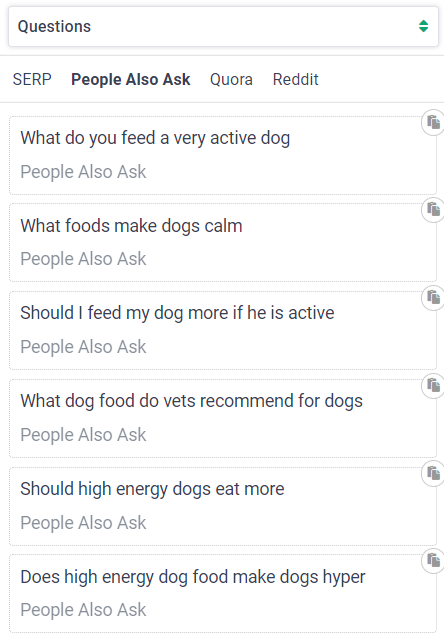
And both of them score your content:

Here are the differences though. Surfer gives you more control over what results from the SERP to analyze:
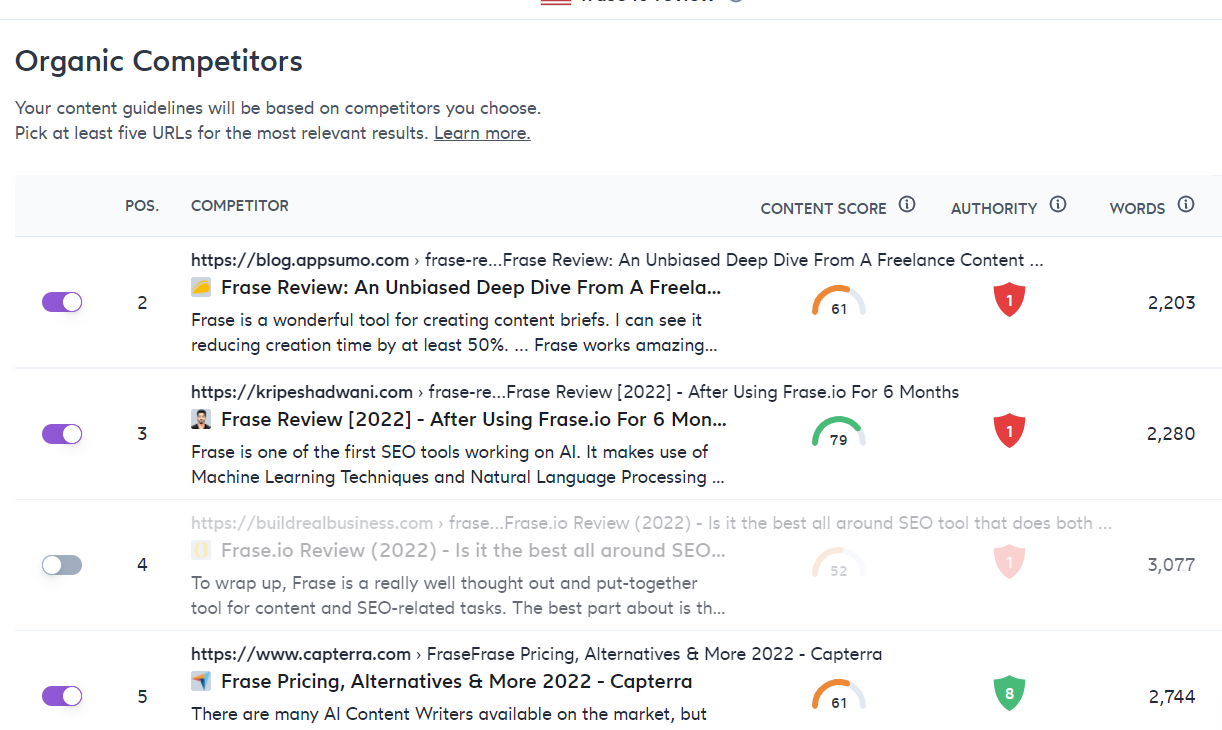
On the other hand, Frase does MUCH more research:

IMO, the key difference is this though:
Surfer is prettier.
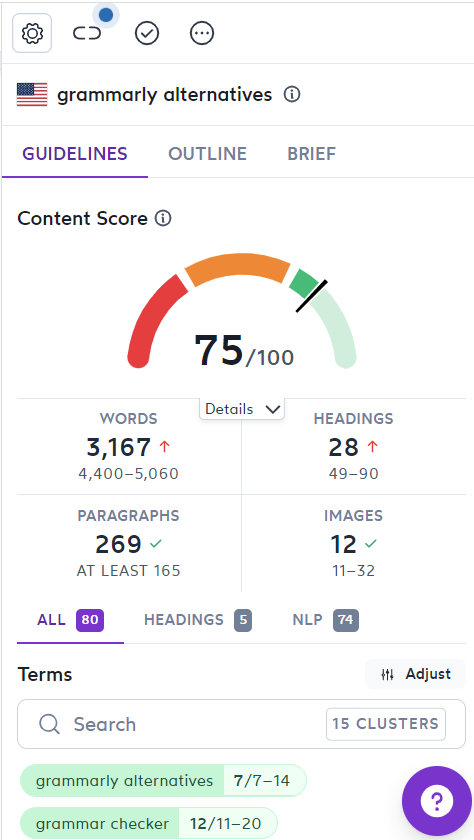
And more convenient, I’d say. For example, it’s easier to see keywords in action in Surfer:

Than it is in Frase:

So if you want more research done automatically, Frase is the better option.
If you want to be pragmatic and get the tool that helps you the most, Surfer is the better choice.
Surfer is the best onpage SEO tool. But you don’t have to take my word for it. Surfer’s results speak for themselves. If you want to see it in action, check our review, or just go ahead and give it a try yourself.
Frase IO vs Jasper AI
Jasper AI is a much more advanced AI writing software. It supports more languages:

It has WAY more templates:

And it’s MUCH easier to create long-form content with it.
You can find out more about it in our Jasper review. Suffice to say, I think it’s better all around than Frase.
So if you just want AI writing, it’s better to get Jasper. And honestly, the other alternatives (Copy AI, Rytr) are better too.
If you want the best AI writing assistant, look no further. While GPT-3 is not as polished as I’d like, Jasper definitely outperforms all of its competitors based on the same technology. It is pricey, I won’t lie. But I think the money’s worth it.
Frase IO vs Market Muse
Market Muse is the only tool that’s a direct competitor to Frase. Meaning that it can do more or less exactly what Frase does: research, content generation, and optimization.
The problem with Market Muse is that it’s not accessible:
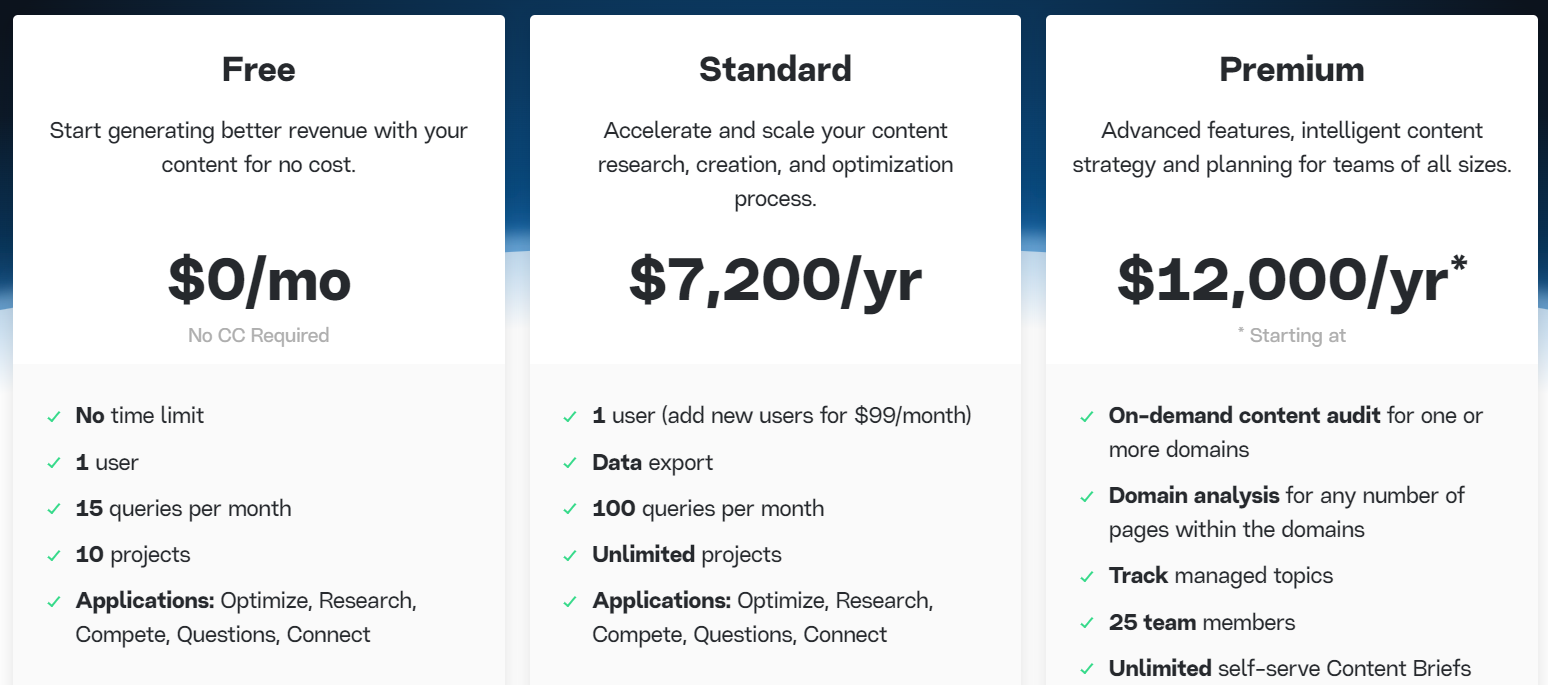
Yeah… most people can’t afford that.
Just by virtue of how expensive it is, Market Muse is honestly in a completely different bracket than Frase IO.
Not to mention, most people actually like Frase IO better.
So if you want a simple tool to help you write faster, check Frase out:
If you want a comprehensive toolset, filled with fancy tools like natural language processing, and you have thousands of dollars to spend, you can look further into Market Muse.
Conclusion: Is Frase IO Right For You
Honestly, I don’t know. I’m hesitant to recommend it. If you want content optimization, Surfer SEO is my go-to recommendation. If you want AI writing, Jasper is definitely better.
But that could honestly be inertia. I’m used to Surfer and Jasper, which means that I may overlook some of Frase’s strong points. It might be amazing if you want to create SEO-optimized content.
So here’s the deal: Frase IO has a lot of helpful tools. The research goes much more in-depth than Surfer. The keyword recommendations and AI writing tools can sometimes be on-par with their competitors.
So if you want them all in one place, I urge you to give Frase a shot:
If you want to check them out separately, read more about Jasper, and Surfer SEO.
Frase IO Review: The Best AI Writer and Researcher in 2024?
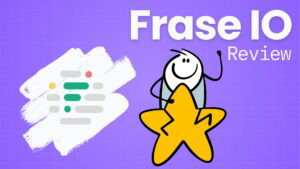
Frase IO is not the best AI writing tool. But its advanced research tools can power up your content production. Find out how in our Frase IO review.
Price: 44.99
Price Currency: $
Application Category: AI Writing Assistant
4




